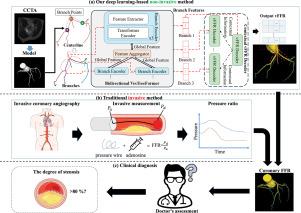Bi-VesTreeFormer: A bidirectional topology-aware transformer framework for coronary vFFR estimation
IF 4.9
2区 医学
Q1 ENGINEERING, BIOMEDICAL
Computerized Medical Imaging and Graphics
Pub Date : 2025-05-11
DOI:10.1016/j.compmedimag.2025.102564
引用次数: 0
Abstract
Fractional Flow Reserve (FFR) serves as the gold standard for evaluating the functional significance of coronary artery stenosis. However, traditional FFR involves the injection of vasodilator drugs and the utilization of additional guidewires, which consequently can lead to patient risks and increased costs. Computational fluid dynamics-based approaches can enable non-invasive virtual FFR (vFFR) estimation, but they are computationally intensive and time-consuming. Although deep learning can remarkably enhance computational efficiency, the existing vFFR methods rely heavily on manually crafted features and face difficulties in capturing long-distance dependencies within the vessel structure. In this study, we propose a novel framework for estimating coronary vFFR, which circumvents the laborious preprocessing procedures of previous methods. Specifically, a novel bidirectional topology-aware transformer network (Bi-VesTreeFormer) is proposed to conduct fully automated topological stenotic feature extraction of the vessel tree and capture the global dependencies among branches. Additionally, a contextual vFFR decoder is introduced to establish the correlation of FFR values between adjacent branches and achieve a stable mapping of FFR values to the latent vector space. To validate and train our method, we gathered FFR data from 43 patients with coronary artery stenosis and simulated 15,000 coronary artery centerline data with a reduced-order hemodynamic model. The results show that the proposed method attains root mean square errors of 0.038 and 0.048 for simulated and real data respectively, surpassing the state-of-the-art methods.

Bi-VesTreeFormer:用于冠状动脉vFFR估计的双向拓扑感知变压器框架
血流储备分数(FFR)是评价冠状动脉狭窄功能意义的金标准。然而,传统的FFR涉及注射血管扩张药物和使用额外的导丝,因此可能导致患者风险和成本增加。基于计算流体动力学的方法可以实现非侵入式虚拟FFR (vFFR)估计,但它们计算量大且耗时。尽管深度学习可以显著提高计算效率,但现有的vFFR方法严重依赖于手工制作的特征,并且在捕获船舶结构内的长距离依赖关系方面存在困难。在这项研究中,我们提出了一个新的框架来估计冠状动脉vFFR,它绕过了以前方法的繁琐的预处理程序。具体而言,提出了一种新型的双向拓扑感知变压器网络(Bi-VesTreeFormer),对血管树进行全自动拓扑狭窄特征提取,并捕获分支之间的全局依赖关系。此外,引入上下文vFFR解码器,建立相邻分支之间FFR值的相关性,实现FFR值到潜在向量空间的稳定映射。为了验证和训练我们的方法,我们收集了43例冠状动脉狭窄患者的FFR数据,并用降阶血流动力学模型模拟了15000条冠状动脉中心线数据。结果表明,该方法对模拟数据和实际数据的均方根误差分别为0.038和0.048,优于现有方法。
本文章由计算机程序翻译,如有差异,请以英文原文为准。
求助全文
约1分钟内获得全文
求助全文
来源期刊
CiteScore
10.70
自引率
3.50%
发文量
71
审稿时长
26 days
期刊介绍:
The purpose of the journal Computerized Medical Imaging and Graphics is to act as a source for the exchange of research results concerning algorithmic advances, development, and application of digital imaging in disease detection, diagnosis, intervention, prevention, precision medicine, and population health. Included in the journal will be articles on novel computerized imaging or visualization techniques, including artificial intelligence and machine learning, augmented reality for surgical planning and guidance, big biomedical data visualization, computer-aided diagnosis, computerized-robotic surgery, image-guided therapy, imaging scanning and reconstruction, mobile and tele-imaging, radiomics, and imaging integration and modeling with other information relevant to digital health. The types of biomedical imaging include: magnetic resonance, computed tomography, ultrasound, nuclear medicine, X-ray, microwave, optical and multi-photon microscopy, video and sensory imaging, and the convergence of biomedical images with other non-imaging datasets.

 求助内容:
求助内容: 应助结果提醒方式:
应助结果提醒方式:


